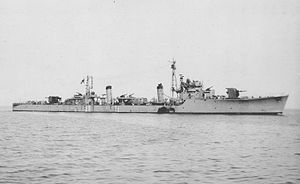Tachibana-class destroyer

Momi, one of the members of this class
|
|
| Class overview | |
|---|---|
| Name: | Matsu class |
| Builders: |
|
| Operators: | |
| Preceded by: |
|
| Subclasses: | Tachibana class |
| Built: | 1943–1945 |
| In commission: | 1944–1971 |
| Planned: |
|
| Completed: |
|
| Cancelled: | 122 |
| Lost: | 10 |
| Retired: | 22 + 1 (JDS Wakaba) |
| General characteristics Matsu class | |
| Displacement: |
|
| Length: |
|
| Beam: | 9.35 m (30 ft 8 in) |
| Draft: | 3.30 m (10 ft 10 in) |
| Propulsion: |
|
| Speed: | 27.8 knots (32.0 mph; 51.5 km/h) |
| Range: | 3,500 nmi (6,500 km) at 18 kn (21 mph; 33 km/h) |
| Complement: | 211 |
| Sensors and processing systems: |
|
| Electronic warfare & decoys: |
1 × 22-Gō surface search radar (wavelength 10 cm) |
| Armament: |
|
| General characteristics Tachibana class | |
| Displacement: |
|
| Length: |
|
| Beam: | 9.35 m (30 ft 8 in) |
| Draft: | 3.41 m (11 ft 2 in) |
| Propulsion: |
|
| Speed: | 27.3 knots (31.4 mph; 50.6 km/h) |
| Sensors and processing systems: |
|
| Electronic warfare & decoys: |
|
| Armament: |
|
| General characteristics Kaiten carrier | |
| Armament: |
|
The Matsu-class destroyers (松型駆逐艦 Matsu-gata kuchikukan) were a class of destroyer built for the Imperial Japanese Navy (IJN), who referred to them as the Type-D Destroyer (丁型駆逐艦 Tei-gata kuchikukan).
The Matsu class were built late in World War II, and they were intended to be more cost-effective in response to the changing character of naval warfare at that time. These ships were lighter and smaller than previous Japanese destroyers, with different armament such as enhanced anti-aircraft guns and anti-submarine weapons, and radar. Since surface warfare was believed to be less likely at this stage of the war, armament such as torpedo tubes that would be useful against surface ships was reduced.
As in other navies during the war, the IJN substantially simplified the design to speed up construction, and used Ōtori class machinery, because high speed was unnecessary for convoy escort operations. However, mass production was not achieved.
The Matsu class design was subsequently further simplified, resulting in the Tachibana-class destroyer (橘型駆逐艦 Tachibana-gata kuchikukan) or Modified Type-D Destroyer (改丁型駆逐艦 Kai Tei-gata kuchikukan). The Tachibana-class destroyers adopted the first modular design in a Japanese destroyer. Matsu-class destroyers whose construction was started late in the programme were completed as Tachibana class.
The IJN converted twelve destroyers to Kaiten mother ships to prepare for the Japanese mainland decisive battle.
...
Wikipedia
